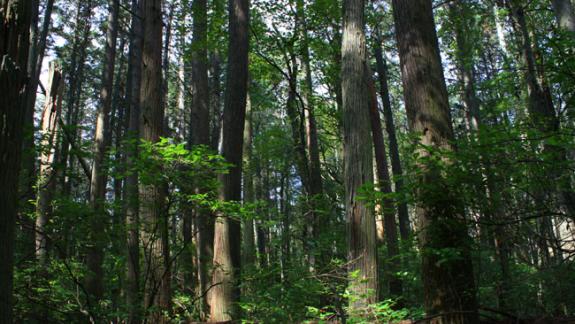Habitat Protection and Restoration in NJ
Each year more and more wildlife habitat is lost to development. We seek to repair degraded and damaged habitat through restoration, enhancement, and creation.
 A stand of Atlantic white-cedar trees in Bass River State Forest, Bass River Township, NJ. © Ben Wurst
A stand of Atlantic white-cedar trees in Bass River State Forest, Bass River Township, NJ. © Ben Wurst
New Jersey is a highly urbanized state, yet it is home to a diverse array of wildlife. From Bobcats to Eastern tiger salamanders, many different species of wildlife live in a variety of habitats found in New Jersey. Our geographic location along the Atlantic Coast helps make it a unique place for wildlife and a globally recognized stopover for migratory birds, bats, and invertebrates. In New Jersey, many rare species are at the farthest extent of their range. For example, the Northern goshawk is at the southern most portion of its breeding range and the Southern gray treefrog is at the northern most part of its range. To protect these species from becoming extirpated from New Jersey, management and conservation are key to species survival. At the Conserve Wildlife Foundation of NJ it is our mission to protect and preserve rare and imperiled species of wildlife that live, breed and migrate through our state through research, species management, habitat restoration, education and citizen engagement.
It is our mission to protect and preserve rare and imperiled species of wildlife.
A wide variety of habitats can be found throughout New Jersey. From our barrier islands and coastal salt marshes, to the diverse pinelands region, then across the state to the hills of the piedmont and the ridges and valleys of the northwest highlands region, no matter where you travel to, this state is rich in biodiversity.
Wildlife need habitat to survive; it is where they feed, rest, and reproduce. Today, only 24% of the landscape in New Jersey is considered to be preserved. Humans continue to alter the landscape and morph natural processes to enhance our lifestyles. Many of the areas that offer suitable habitat for wildlife are small and fragmented, divided by highways, strip malls, and housing developments. Habitat loss is considered to be the leading cause of species extinctions. Current extinction rates are believed to be 1000 to 10,000 times greater than the normal rate (Wilson 1988). We work to protect habitat by supporting open space initiatives like the Green Acres Program and reverse habitat loss through restoration.
Habitat loss is considered to be the leading cause of species extinctions.
Our Habitat Program not only helps restore habitat for wildlife, but it also provides a philosophy and a way of reversing long-term trends in habitat loss. Habitat restoration is the “process of assisting the recovery of an ecosystem that has been degraded, damaged, or destroyed” (SER 2004). Habitat restoration not only benefits wildlife, but it also benefits people and their surroundings.
Many people value the environment for hundreds of reasons, clean air, water, and open space for outdoor recreation. It helps to restore value to ecosystems by filtering pollutants and retaining stormwater. It connects fragmented habitat which allows wildlife to migrate and disperse freely. It provides additional recreational opportunities and boosts the aesthetic value of native ecosystems. We create educational opportunities for the public by using interpretive signs and by using volunteers to assist with project construction.
References:
Society for Ecological Restoration International Science & Policy Working Group. 2004. The SER International Primer on Ecological Restoration.
Wilson, E. O. (1988). Biodiversity. Washington DC: National Academy. ISBN 0-309-03739-5
Find Related Info: Habitat Restoration






